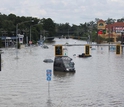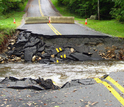
Research News
Inland flood zones often overlooked, leading to need for more risk awareness
June 21, 2017
Find related stories on NSF’s Environmental Research and Education (ERE) Programs at this link.
Flooding is not only the most common natural disaster — it’s the natural disaster that kills the greatest number of people.
As the threat of floods increases worldwide, scientists have been gathering valuable information on vulnerability to floods in counties throughout the U.S.
The results are published in the journal Annals of the American Association of Geographers.
Trends from 2001 to 2011 show that urban development has declined in coastal flood zones; however, development in flood zones in inland counties has grown.
“We found more urban development in inland flood zones than in coastal areas between 2000 and 2011, which is a worrisome trend,” said scientist Nina Lam of Louisiana State University, a co-author of the study. “The implications are that people living in the coastal zone want to migrate inland. But they don’t realize they are still vulnerable if they live in flood zones in inland areas.”
The trend may point to a need for more awareness, education and communication about flood risk in inland counties, the researchers said. They believe that more affordable housing in non-flood zones and strategies to mitigate floods are also needed.
“These results show that people in coastal areas are more aware of flood threats than those living in inland flood zones, and that populations in inland areas are increasing,” said Judy Skog, a director of the National Science Foundation’s (NSF) Coastal SEES (Science, Engineering and Education for Sustainability) program, which funded the research. “This information could aid future flood-planning efforts in inland communities.”
The researchers compiled urban development, flood hazard and census data and overlaid it on a map of the U.S.
Although the analysis shows that Americans have become more aware of the risk of floods over the 10-year study period, the researchers identified several U.S. hotspots where urban development has grown in flood zones, including those near New York City and Miami.
“Flooding is the most common and widespread disaster we face nationally, and the one that is the easiest to alleviate by effective planning,” said Richard Yuretich, a director of NSF’s Dynamics of Coupled Natural and Human Systems program, which co-funded the research. “This study provides important data on flood hazards across the country, and demonstrates that research and education about floods over the past decade have helped manage risk. Yet there are still places where people are in harm’s way.”
The three counties in the U.S. with the largest concentration of people living in flood zones are near the Gulf of Mexico: Cameron Parish in Louisiana, with 93.6 percent of its population in the flood zone; Monroe County in Florida, with 91.4 percent of its population in the flood zone; and Galveston County in Texas, with 82.8 percent of its population in the flood zone.
The research focused on the U.S., but scientists see the potential for the results to help address a worldwide threat. “This nationwide study of flood zones, human populations and urban development provides a tool that could be used globally,” Skog said.
—
Cheryl Dybas,
NSF
(703) 292-7734 cdybas@nsf.gov
—
Alison Satake,
LSU
(225) 578-3870 asatake@lsu.edu
-
Floods in August of last year wreaked havoc throughout Baton Rouge, Louisiana.
Credit and Larger Version -
Cameron Parish in Louisiana has 93 percent of its population living in the flood zone.
Credit and Larger Version -
Natural “green barriers” help protect Florida infrastructure from severe storms and floods.
Credit and Larger Version -
Extreme rainfall events may result in flood risks to infrastructure such as roads.
Credit and Larger Version -
A look into the past: a flooded Market Street in Galveston, Texas, after a 1915 hurricane.
Credit and Larger Version
Investigators
Kehui Xu
Nina Lam
Qin Chen
YiJun Xu
Kam-biu Liu
Margaret Reams
Robert Twilley
Samuel Bentley
Victor Rivera-Monroy
Related Institutions/Organizations
Louisiana State University & Agricultural and Mechanical College
Related Programs
Coastal SEES
Dynamics of Coupled Natural and Human Systems
Related Awards
#1427389 Coastal SEES Collaborative Research: Changes in actual and perceived coastal flood risks due to river management strategies
#1212112 CNH: Coupled Natural-Human Dynamics in a Vulnerable Coastal System
Total Grants
$2,597,639
Source: NSF News
Brought to you by China News










